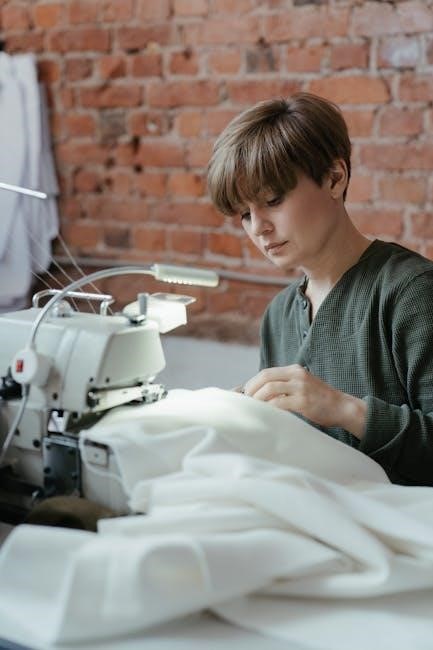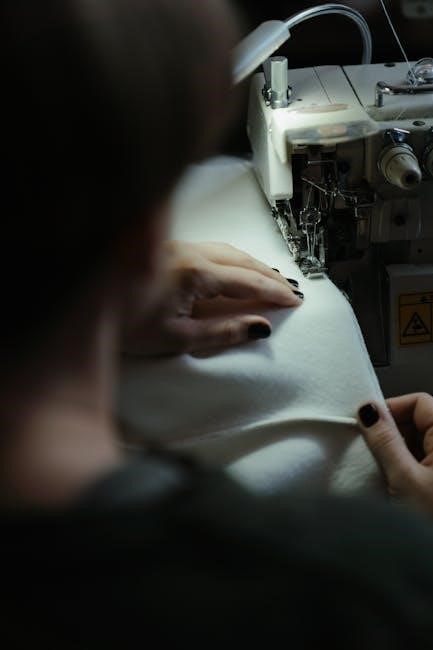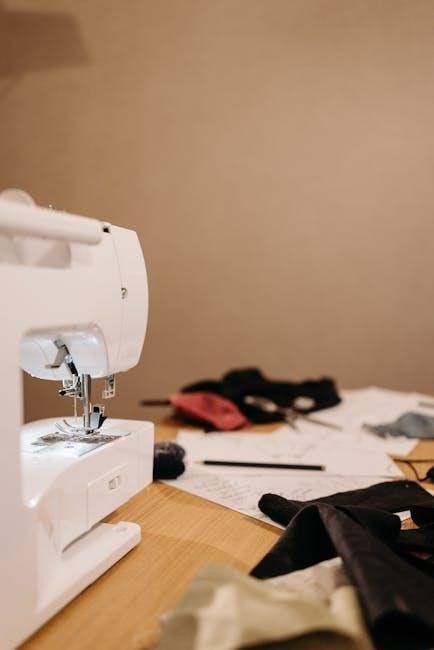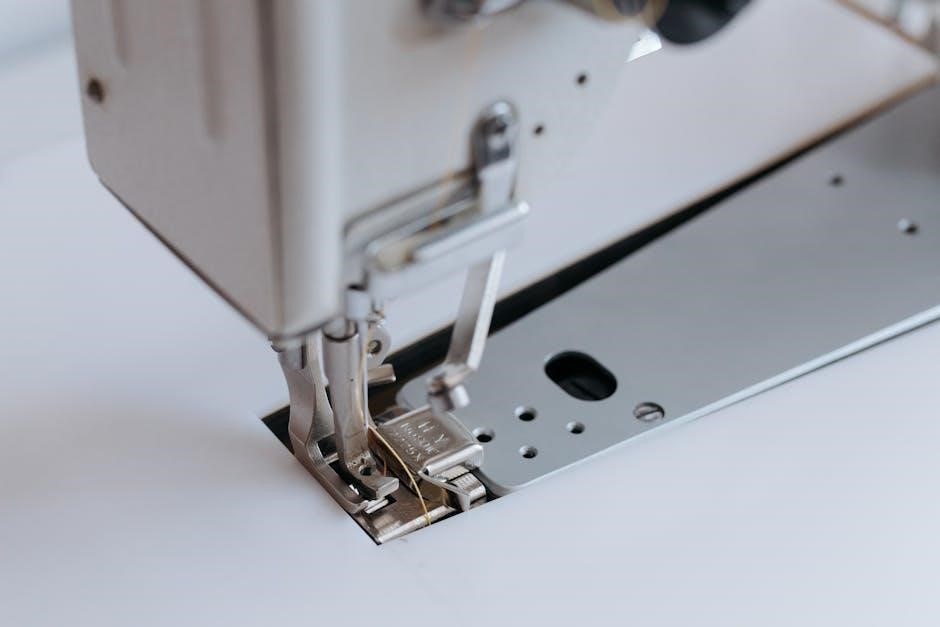
Singer sewing machines are iconic, reliable tools for sewists of all levels, offering durability, versatility, and innovative features. With a legacy spanning over 170 years, they remain a top choice for crafting, repairs, and embroidery projects, combining tradition with modern technology for unmatched sewing experiences.
History of Singer Sewing Machines
Singer Sewing Machines have a rich history dating back to 1851, founded by Isaac Merritt Singer. The company revolutionized sewing with its first practical machine, making it accessible for home and industrial use. Over the years, Singer machines evolved, introducing innovative features and models, such as the iconic Featherweight. Vintage Singer machines are now highly collectible, reflecting their historical significance. The brand has maintained its reputation for durability and reliability, becoming a trusted name in sewing. Today, Singer continues to innovate, offering a range of machines from basic to advanced models, catering to sewists of all skill levels and projects.
Why Choose a Singer Sewing Machine?
Singer sewing machines are a top choice for sewists due to their unmatched durability, versatility, and innovative features. With a legacy spanning over 170 years, Singer machines are known for their reliability and high-quality performance. They cater to all skill levels, from beginners to advanced sewists, offering a wide range of models. Whether for basic repairs, creative projects, or heavy-duty tasks, Singer machines deliver exceptional results. Their advanced features, such as computerized stitch patterns and embroidery functions, make them ideal for modern sewing needs. Singer’s commitment to innovation and user-friendly designs ensures a seamless sewing experience, making them a trusted choice for generations.
Identifying Your Singer Sewing Machine
Identifying your Singer sewing machine involves locating the serial number and model number, which are key to determining its age, factory, and specific features. Online resources like ismacs.org provide detailed databases to help you identify your machine accurately. Knowing your machine’s model and serial number is essential for finding compatible parts, troubleshooting, and understanding its history. This information also helps in assessing the machine’s value, especially for vintage or collectible models like the Singer 221-1 Featherweight, which are highly sought after by enthusiasts.
How to Find the Serial Number
Understanding Model Numbers
Model numbers are crucial for identifying specific Singer sewing machine features and compatibility. Typically located near the serial number, they consist of a combination of letters and numbers. For example, the Singer 221-1 Featherweight denotes a lightweight, portable machine. Understanding the model number helps in finding the correct manuals, parts, and accessories; Some models, like the Heavy Duty series, indicate robust construction for thick fabrics. Vintage models may have unique numbering systems, while modern machines often have more standardized codes. Knowing your model number ensures you can purchase the right supplies and access tailored support for your sewing needs. This step enhances your overall sewing experience.
Using Online Resources for Identification
Online resources are invaluable for identifying Singer sewing machines. Websites like ismacs.net provide detailed databases to look up serial numbers, model specifics, and production dates. Singer’s official website offers digital manuals, troubleshooting guides, and parts catalogs. Additionally, online forums and sewing communities share insights and tips for identifying vintage and modern models. These platforms help users determine machine compatibility, repair needs, and maintenance schedules. By utilizing these resources, sewists can ensure they are using the correct accessories and receiving accurate support for their machines, enhancing both functionality and longevity. Online tools simplify the process of understanding and caring for your Singer sewing machine.
Setting Up Your Singer Sewing Machine
Unpack and prepare your Singer machine, ensuring all parts are included. Thread carefully, install the bobbin, and perform basic maintenance like cleaning and oiling. Refer to the manual for model-specific setup tips to ensure optimal performance and longevity.
Unpacking and Preparing the Machine
When unpacking your Singer sewing machine, carefully remove it from the box and inspect for any damage. Ensure all accessories, like bobbins, needles, and the power cord, are included. Place the machine on a stable, flat surface. Before use, clean any dust or packaging residue with a soft cloth. Refer to the manual for specific assembly instructions, as some models may require attaching parts like the sewing table or spool pins. Plug in the machine and test basic functions to ensure it operates smoothly. Proper preparation ensures longevity and optimal performance for your sewing projects.
Threading the Machine
Threading your Singer sewing machine is a straightforward process when done correctly. Always turn off the machine before threading to ensure safety. Begin by locating the spool pin and draw the thread through the machine’s tension discs. Gently pull the thread to guide it through the take-up lever and needle. Use the manual to confirm the correct threading path for your specific model. Ensure the thread is seated properly in the tension disks and the take-up lever is in the correct position. Avoid pulling too tightly, as this can misalign the thread. Test the thread by gently tugging it to ensure smooth flow. Proper threading is essential for consistent stitching and prevents common issues like thread tangling or breaking.
Bobbin Setup and Installation
Proper bobbin setup is crucial for smooth stitching. Begin by selecting the correct bobbin size for your machine, ensuring it matches the Singer model. Insert the bobbin into the bobbin case, aligning the notch with the case’s guide. Wind thread around the bobbin evenly, leaving a small tail. Place the bobbin into the machine’s bobbin area, ensuring it sits securely. Close the bobbin cover and gently pull the thread to set the tension. Always refer to your Singer manual for specific instructions, as models may vary. Proper installation ensures consistent stitching and prevents issues like bobbin jams or uneven tension. Regularly check and replace worn bobbins to maintain optimal performance.
Basic Sewing Functions
Mastering basic sewing functions is essential for any project. Start with a straight stitch, adjust tension, and explore various stitch patterns for different fabrics and designs. Ensure proper thread management and fabric alignment for consistent results.
Starting Your First Stitch
Starting your first stitch on a Singer sewing machine is straightforward. Begin by ensuring the machine is properly threaded and the bobbin is installed correctly. Select a straight stitch pattern and set the tension appropriately for your fabric type. Place a scrap piece of fabric under the presser foot, aligning the edge with the machine’s guide. Gently lower the presser foot and slowly start sewing. Keep the fabric steady and let the machine guide it smoothly. Practice on scrap fabric to get a feel for the stitch length and speed. This will help you achieve consistent results and build confidence in your sewing skills.
Adjusting Tension
Proper tension adjustment is essential for achieving even stitches on your Singer sewing machine. Start by threading the machine correctly and ensuring the bobbin is installed properly. Locate the upper tension dial, usually found on the front or top of the machine. Turn the dial to increase or decrease tension—tighter for heavier fabrics and looser for lightweight materials. Test the tension by sewing a straight line on scrap fabric. If the stitches are uneven, adjust the dial slightly and retest. For optimal results, use the same thread type in both the needle and bobbin. Always refer to your user manual for specific guidance, as tension settings may vary by model.
Using Different Stitch Patterns
Singer sewing machines offer a variety of stitch patterns to suit different fabrics and projects. To use these patterns, start by selecting the desired stitch using the dial or button on your machine. For mechanical models, this is often a straightforward process, while computerized machines may require navigating a digital menu. Always refer to your user manual for specific instructions tailored to your model. Once selected, adjust the stitch length and width as needed for optimal results. Test the stitch on scrap fabric before sewing your final project to ensure the settings are correct. Exploring these patterns will enhance your sewing creativity and precision.
Maintenance and Care
Regular maintenance ensures your Singer sewing machine runs smoothly. Clean the machine, oil moving parts, and check for wear. Use genuine parts and follow manual guidelines for optimal performance.
Cleaning the Machine
Regular cleaning is essential for maintaining your Singer sewing machine’s performance. Turn off and unplug the machine before cleaning. Use a soft brush to remove lint and debris from the bobbin area, tension discs, and stitch plate. Gently wipe the exterior with a dry, soft cloth to prevent dust buildup. Avoid harsh chemicals, as they may damage the finish. For internal cleaning, refer to your manual or use compressed air carefully. Cleaning after each project prevents thread residue and ensures smooth operation. Regular maintenance helps extend the machine’s lifespan and keeps it functioning optimally for years of reliable service.
Oiling and Lubrication
Proper oiling and lubrication are crucial for maintaining your Singer sewing machine’s smooth operation. Always use high-quality sewing machine oil, as specified in your user manual. Locate the oiling points, typically found in the bobbin area, handwheel, or other moving parts. Apply a few drops of oil to these points after cleaning or every 10 hours of use. Avoid over-oiling, as it can attract dust and dirt. Regular lubrication prevents friction, reduces wear, and ensures the machine runs quietly and efficiently. Refer to your manual for specific guidance, as oiling requirements may vary depending on the model and usage frequency.
Regular Maintenance Tips
Regular maintenance ensures your Singer sewing machine performs optimally and lasts longer. Set a routine to clean the machine after each use, removing lint and debris from the bobbin area and tension discs. Use a soft brush or compressed air for thorough cleaning. Check for dust buildup in visible parts and wipe it away with a dry cloth. Lubricate moving parts periodically, as specified in your manual, to prevent friction and wear. Avoid using harsh chemicals, as they can damage the finish. Store your machine in a dry, cool place when not in use. For best results, use Singer-approved parts and accessories to maintain performance and longevity.

Troubleshooting Common Issues
Addressing common issues like thread breaking, bobbin problems, or machine malfunction can be done by checking tension settings, ensuring proper threading, and consulting the user manual for solutions.
Thread Breaking or Tangling
Thread breaking or tangling is a common issue that can disrupt your sewing flow. To resolve this, ensure the thread is properly threaded through the machine’s tension discs and take-up lever. Check for any knots or twists in the thread and gently remove them. Using high-quality thread and maintaining consistent tension can prevent such issues. Additionally, cleaning the machine regularly and ensuring the needle is correctly installed can help reduce thread breakage. If problems persist, consulting the user manual or seeking expert advice is recommended to ensure optimal performance and extend the machine’s lifespan.
Machine Not Turning On
If your Singer sewing machine won’t turn on, ensure it is properly plugged into a functioning electrical outlet. Verify that the power cord is undamaged and securely connected to both the machine and the power source. Check your home’s circuit breaker or fuse box to rule out a blown fuse or tripped breaker. If the issue persists, inspect the machine’s power switch for damage or wear. In some cases, a faulty motor or electrical component may be the cause. Contact a professional repair service if the problem cannot be resolved independently. Regular maintenance and electrical checks can help prevent such issues and ensure your machine runs smoothly.
Bobbin Issues
Bobbin issues can disrupt your sewing experience, but they are often easy to resolve. Using the wrong bobbin size or type is a common mistake, leading to poor stitch quality or machine jams. Ensure the bobbin is properly seated and aligned in the bobbin case. If the bobbin is loose or tightly wound, adjust the tension according to the user manual. Regularly clean the bobbin area to prevent lint buildup, which can cause mechanical problems. Always use genuine Singer bobbins to maintain compatibility and performance. If issues persist, consult the troubleshooting guide or contact Singer support for assistance.

Accessories and Parts
Essential Singer sewing machine accessories enhance functionality. Genuine parts ensure compatibility and performance. Find needles, bobbins, and presser feet online. Use Singer-approved products for optimal results and longevity.
Essential Accessories for Singer Machines
Essential accessories for Singer sewing machines include high-quality needles, bobbins, and presser feet, which ensure optimal performance. Additional items like sewing notions, extension tables, and carrying cases enhance convenience. Genuine Singer parts are recommended for compatibility and durability. Accessories like embroidery hoops and quilting guides expand creative possibilities. Regularly updating and maintaining these components keeps your machine running smoothly. Always purchase from authorized dealers or Singer’s official website to avoid counterfeit products. Proper care and use of accessories extend the machine’s lifespan and improve stitching quality. These tools are vital for achieving professional-grade results and maximizing your sewing experience with Singer machines.
Where to Buy Genuine Parts
Genuine Singer sewing machine parts can be purchased directly from Singer’s official website or authorized dealers. These sources ensure authenticity and compatibility. Additionally, trusted online retailers verified by Singer are reliable options. Avoid third-party sellers unless they are Singer-approved to prevent counterfeit products. Singer’s customer support can also assist with parts inquiries. Always check the user manual or Singer’s support resources for direct links or recommendations. Purchasing from these verified sources guarantees that parts are designed specifically for your machine, maintaining its performance and longevity.
Using Compatible Third-Party Accessories
While Singer recommends genuine parts, compatible third-party accessories can be a cost-effective alternative. Research reputable brands and read reviews to ensure quality and compatibility with your Singer model. Online marketplaces like Amazon or specialized sewing stores often carry a wide range of accessories. Always check the product description or packaging for compatibility with your machine’s make and model. For vintage or older models, sewing communities and forums can be valuable resources for finding suitable third-party parts. Ensure that any accessory meets Singer’s specifications to maintain performance and avoid damage. Compatibility is key to ensuring your machine functions optimally with third-party additions.

Advanced Features
Singer sewing machines offer advanced features like computerized stitch patterns, embroidery functions, and customizable settings, allowing for precise control and creativity in various sewing and embroidery projects.
Computerized Stitch Patterns
Modern Singer sewing machines feature advanced computerized stitch patterns, offering a wide range of decorative, utility, and heirloom stitches. These patterns are easily navigable via an LCD screen, allowing users to preview and select stitches effortlessly. Many models also include the ability to customize stitch length, width, and density, ensuring precise control over every project. Additionally, some machines allow users to save their favorite stitches or combinations, enhancing creativity and efficiency. These computerized features cater to both beginners and advanced sewists, making it easy to tackle complex designs or simple repairs with professional results. The versatility of these stitch patterns makes Singer machines ideal for various fabrics and sewing tasks.
Embroidery Functions
Singer sewing machines with embroidery functions offer advanced capabilities for creating intricate designs and patterns. These machines often feature large embroidery hoops, customizable designs, and USB connectivity for importing digital patterns. Users can choose from pre-programmed embroidery designs or create their own using specialized software. The machines typically include touchscreens for easy navigation and real-time previews of embroidery work. Many models also allow for adjustable embroidery speeds, ensuring precise stitching on various fabrics. Additionally, some Singer embroidery machines include built-in memory to store custom designs, making it convenient to access favorite patterns. These features make Singer embroidery machines ideal for hobbyists and professionals alike, offering endless creative possibilities for personalized projects.
Customizing Your Machine
Customizing your Singer sewing machine allows you to tailor it to your sewing style and preferences. Many models offer the ability to add custom stitches, personalize embroidery designs, and even adjust settings like tension and stitch length. Some machines allow for downloadable stitches from the Singer website, expanding your creative options. You can also personalize your machine with custom decals or accessories. Additionally, advanced models may permit reconfiguring the control panel or saving frequently used settings. These customization features empower users to enhance their sewing experience, making their machine truly unique and suited to their specific needs and projects.
Users Guide to Manuals
Singer offers comprehensive digital manuals for both new and vintage machines, easily downloadable online, providing detailed guidance for setup, maintenance, and troubleshooting, ensuring seamless operation for all users.
Understanding Your User Manual
Your Singer sewing machine user manual is a comprehensive guide designed to help you maximize your machine’s potential. It typically includes detailed instructions for setup, maintenance, and troubleshooting, ensuring you can address common issues efficiently. The manual also covers advanced features, such as stitch customization and embroidery functions, allowing you to explore creative possibilities. Many manuals are now available in digital formats, making them easily accessible and searchable. By understanding your manual, you can enhance your sewing skills, prolong your machine’s lifespan, and make the most of its capabilities. Always refer to your manual for model-specific guidance and tips tailored to your Singer machine.
Downloading Digital Manuals
Downloading digital manuals for your Singer sewing machine is a convenient way to access guidance anytime. Many Singer manuals are available online, including vintage models, through official Singer websites or trusted resources like ismacs.org. Simply search using your machine’s serial number to find the correct manual. Digital formats offer easy navigation and search functionalities, making it simpler to find specific instructions or troubleshooting tips. For older machines, some manuals may be available as free PDF downloads, ensuring you can maintain and operate your Singer effectively. Always verify the source to ensure authenticity and safety when downloading manuals online.
Troubleshooting Guide
Troubleshooting Guide
The Singer sewing machine troubleshooting guide helps resolve common issues quickly. For thread breaking or tangling, check tension settings and ensure proper threading. If the machine won’t turn on, inspect the power cord, plug, and circuit breaker. Bobbin issues often arise from incorrect installation or alignment—refer to your manual for guidance. Regular maintenance, such as cleaning and oiling, prevents many problems. Consult online resources or expert forums for additional support. Always follow safety precautions and use genuine Singer parts for repairs. This guide ensures your machine runs smoothly, helping you achieve professional results with minimal downtime.

Expert Support and Resources
Access comprehensive support through Singer’s official website, including warranties, manuals, and repair centers. Online forums and communities offer additional troubleshooting tips and expert advice for optimal machine performance.
Warranty and Support Options
Singer offers comprehensive warranty programs, ensuring coverage for parts and labor on new machines. Dedicated customer support is available through various channels, including phone, email, and live chat. Additionally, Singer provides access to authorized service centers for repairs and maintenance. Online resources, such as troubleshooting guides and FAQs, help users resolve common issues independently. Extended warranty options are also available for added protection. With a focus on customer satisfaction, Singer ensures that users have access to the assistance they need to keep their machines in optimal condition. This support network enhances the overall sewing experience, providing peace of mind for sewists of all levels.
Online Communities and Forums
Online communities and forums are invaluable resources for Singer sewing machine users, offering a space to connect, share ideas, and solve problems. Platforms like Singer’s official forums, sewing groups on Facebook, and specialized sewing communities provide access to tips, tutorials, and troubleshooting advice from experienced users. These forums are great for discussing machine-specific issues, learning new techniques, and discovering accessories. Many users also share their projects, inspiring creativity and fostering a sense of camaraderie. Whether you’re a beginner or an advanced sewist, these communities offer support and guidance to help you make the most of your Singer sewing machine experience.
Repair and Service Centers
Repair and Service Centers
Authorized Singer repair and service centers are essential for maintaining the optimal performance of your sewing machine. These centers, staffed by skilled technicians, specialize in Singer models, ensuring expert care for routine maintenance, repairs, and upgrades. They offer genuine parts, ensuring compatibility and longevity, and provide guidance on troubleshooting common issues. Regular servicing at these centers can extend your machine’s lifespan and maintain its efficiency. Additionally, many centers offer resources like manuals and troubleshooting guides to help you address minor issues independently. By leveraging these professional services, you can keep your Singer sewing machine in top condition, ready for all your sewing projects.
Singer sewing machines are reliable companions for sewists, offering a legacy of quality and versatility. Proper care and exploration of their features ensure lasting performance and creative satisfaction.
Singer sewing machines are renowned for their durability and versatility, catering to all skill levels. Proper identification via serial numbers and model numbers is essential for parts and maintenance. Regular cleaning, oiling, and tension adjustments ensure optimal performance. Troubleshooting common issues like thread tangling or bobbin problems can extend machine longevity. Accessories and genuine parts enhance functionality, while online communities and manuals provide invaluable support. Singer’s legacy of innovation, from basic to advanced features, makes them a trusted choice for sewists worldwide. By following these guidelines, users can maximize their machine’s potential and enjoy a seamless sewing experience.
Final Tips for Getting the Most Out of Your Machine
Regular maintenance, such as cleaning and oiling, ensures your Singer sewing machine runs smoothly. Always use compatible needles and threads to prevent damage. Experiment with stitch patterns for diverse projects and adjust tension settings for different fabrics. Refer to your user manual for specific guidance tailored to your model. Keep your machine in a dry, dust-free environment to preserve its longevity. Stay updated with the latest features by exploring Singer’s online resources or joining sewing communities. By following these tips, you can enhance your sewing experience, extend your machine’s lifespan, and achieve professional-quality results in every project.